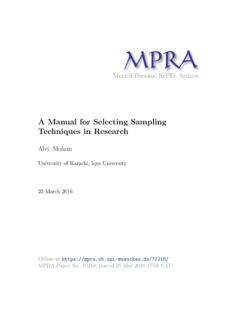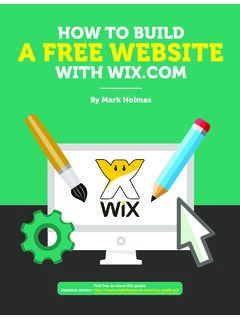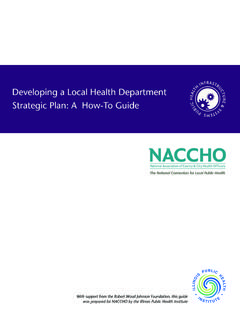Transcription of Selecting and Describing Your Research Instruments
1 Copyright American Psychological Association Contents Series Foreword ix Acknowledgments xiii Introduction 3. Chapter 1. Identifying and Defining the Constructs and Variables to Measure 9. Chapter 2. Types of Instruments and Their Properties: Methods to Measure Variables and Constructs 19. Chapter 3. Identifying Available Instruments 31. Chapter 4. Gathering and Organizing Information About Instruments 45. Chapter 5. Permissions and Feasibility 57. Chapter 6. Using the Evidence to Guide Your Instrument Selection 65. Chapter 7. Following Ethical Principles and Guidelines 73. Chapter 8. Describing Instruments Effectively for Different Audiences 81. Chapter 9. Troubleshooting 91. vii Copyright American Psychological Association Contents Conclusion 103. Glossary 107. References 111. Index 115. About the Author 123. About the Series Editor 125.
2 Viii Copyright American Psychological Association Introduction I f you are reading this book, you may have an idea for a Research study. You may have a Research question in mind or even an idea of the method you would like to use. A Research question is a broad ques- tion about the topic a researcher is studying. A Research method is the methodical and scientific process a researcher uses to answer a Research question. At whatever stage you find yourself in designing a study, the time has come to think more carefully about how you will measure the psycho logical or social science concepts you wish to study. This con- cise guide will provide all the information you need to choose the right instrument for your specific study. In psychology, Research Instruments are tools used to observe and describe psychological phenomena in a way that provides data that can be analyzed.
3 Have you ever watched a concert and seen the guitarist pick up a dif- ferent guitar between songs or maybe even within the same song? This is Selecting and Describing Your Research Instruments , by K. S. McClure Copyright 2020 by the American Psychological Association. All rights reserved. 3. Copyright American Psychological Association Selecting AND Describing YOUR Research Instruments . because, in a concert, each instrument (in this example, a specific type of guitar) may produce a unique sound that best fits the song, the acoustics of the venue, the musicians in the band, or some combination of factors that impact how the audience experiences the music. Both guitars do the same basic job of making sounds by plucking and strumming strings. However, the fit of each guitar with a particular song is related to the goals of the musicians making the music.
4 The same is true of Research instru- ments in psychology and the social sciences. Instead of making music, in Research you are asking questions about psychology or other social science concepts. It is critical that you select the best instrument to measure each concept you study. You will have many choices to make about the Research Instruments you use for your study. For example, did you know that there are over 100 Instruments available just to measure depression? Just like all guitars make music with strings, all these Instruments measure depression. How- ever, each instrument is designed for a specific type of goal, setting, format, or Research participant. How does a researcher choose which instrument to use? New researchers are often surprised to learn that instrument selec- tion is a complex and important step in the process of Research design.
5 This concise guide will show you how to identify the Instruments that are available for your study, select the best Instruments for the job, and describe the Instruments so that others will know how and why you made your decisions. You may also find that the skills you develop and prac- tice ( , goal setting, creating a detailed plan, creating and sticking to a timeline, digging deeper to find information, organizing large quantities of information, and collaborating) will transfer effectively to most jobs in a wide range of settings. WHY AN ENTIRE GUIDE. ON INSTRUMENT SELECTION? If you were going to buy a guitar, you would probably gather some infor- mation about the different models and pricing before making your deci- sion. The same is true for Research Instruments . All Research Instruments 4. Copyright American Psychological Association Introduction have limitations, and Selecting the best instrument for a specific study requires weighing the instrument's strengths against its weaknesses for the specific task at hand.
6 There is a lot to consider , including whether the instrument accurately measures the experiences and problems of the pop . ulation with individual differences and diverse identities, languages, abili . ties, and other characteristics. Instrument selection is where researchers get to make some important choices that will impact the entire study, so it requires a careful and informed decision-making process. Unfortunately, if you do not give instrument selection some time and care, it may be dif . ficult to interpret the results of your study later. I hope this guide will help you select the right Instruments for the job before you collect and analyze your data so that you will be confident in your conclusions. HOW TO USE THIS GUIDE. This guide is intentionally brief so that you can read it quickly and easily. Each chapter focuses on a specific aspect of instrument selection.
7 It is designed to be read from beginning to end. There are a lot of examples to show you the concepts. There are also worksheets for you to fill out along the way. The worksheets are in the text, and I will explain when to use them. I recommend copying the worksheets so that you can use them again for your next study. (This may be the first study that you design, and hopefully, it is not your last!) You will get the most out of this guide if you complete the worksheets along the way. They will help you understand the concepts, keep track of your work, and document the steps you have taken while Selecting your Instruments . The worksheets are also designed to be communication tools, so take the completed worksheets to your advising meetings to help you explain the work you have done. Research is best when it is conducted in a team. Building a team and consulting with an advisor is often a new skill for new researchers.
8 As a Research advisor, I have seen students get to the end of their projects before I realized that they did not fully consult with me. This step can slip through the cracks when students do not know what questions to ask, when to ask them, or when it is appropriate to reach out for consultation. 5. Copyright American Psychological Association Selecting AND Describing YOUR Research Instruments . This brings us to your first exercise. Figure 1 provides a list of issues you should discuss with your advisor as you go through the process of Selecting and Describing your Research Instruments . It is meant to be filled out over time. Take a minute to read it now so that you are familiar with the issues you will discuss with your advisor. Then place a check next to Item 1 on the checklist to indicate that you reviewed the worksheet. Advisor Consultation Checklist Use the checklist below to ensure that you consulted with your advisor during the key steps in the process of Selecting and Describing your Research Instruments .
9 1. _____ Read this checklist 2. _____ Made an appointment for our first meeting to discuss the instrument selection 3. _____ Showed my advisor this checklist 4. _____ Reviewed Figure , The Present Study Research Question, Aim, and Hypotheses Worksheet 5. _____ Reviewed Figure , Examples of Study Constructs 6. _____ Reviewed Figure , Search Term Note-Taking Worksheet 7. _____ Discussed what languages the population of interest may speak 8. _____ Discussed accessibility considerations for the population of interest 9. _____ Reviewed Figure , Possible Instruments Note-Taking Worksheet 10. _____ Discussed permissions that will be required 11. _____ Reviewed Figure , Decision-Making Worksheet 12. _____ Discussed which demographic variables and whether confounding variables will be measured 13. _____ Discussed whether institutional review board (IRB) approval is required and, if applicable, how to apply 14.
10 _____ Discussed potential grants to cover the cost of the study 15. _____ Discussed whether to develop an instrument if one does not exist 16. _____ Reviewed efforts to obtain permission when permissions could not be secured 17. _____ Reviewed the descriptions of the Instruments for my study proposal 18. _____ Reviewed the descriptions of the Instruments for my IRB application 19. _____ Reviewed the descriptions of the Instruments for my final manuscript Figure 1. Advisor consultation checklist. 6. Copyright American Psychological Association Introduction As you work your way through this guide, check off each item that you complete in your Advisor Consultation Checklist. This is also a good time to begin Item 2 on the Advisor Consultation Checklist. Contact your advisor to request a 15- to 30-minute appoint- ment for a date 1 to 2 weeks from now.



















